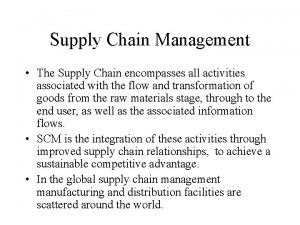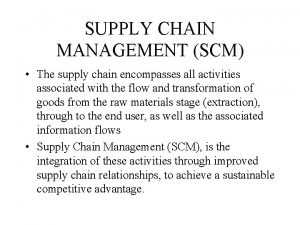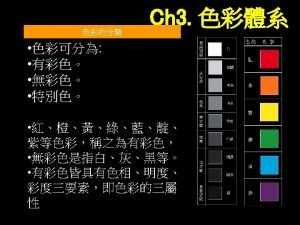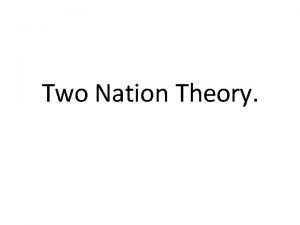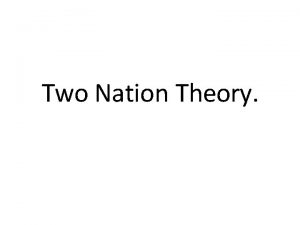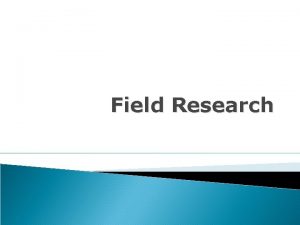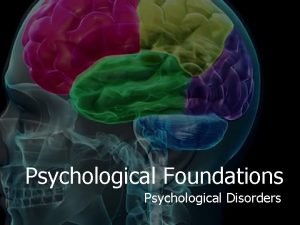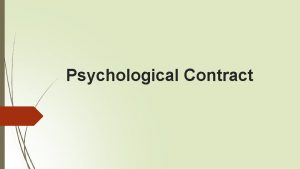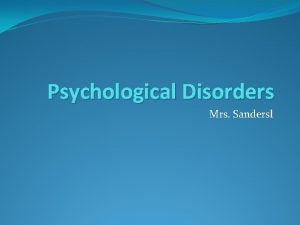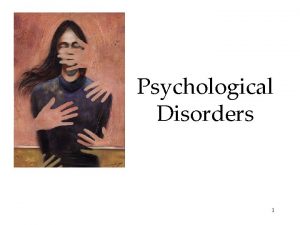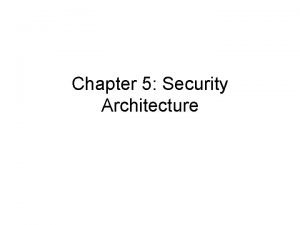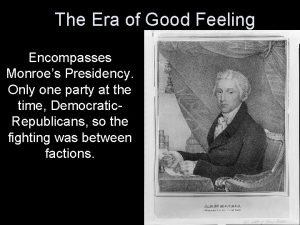Psychological Theory Psychological Theory The Psychological encompasses two


















- Slides: 18

Psychological Theory

Psychological Theory The Psychological encompasses two almost contradictory critical theories. The first focuses on the text itself, with no regard to outside influences; the second focuses on the author of the text.

Psychological Theory According to the first view, reading and interpretation are limited to the work itself. One will understand the work by examining conflicts, characters, dream sequences, and symbols.

Psychological Theory One will further understand that a character’s outward behavior might conflict with inner desires or might reflect as-yet-undiscovered inner desires.

Main Areas of Study/Points of Criticism of the First View There are strong Oedipal connotations in this theory: • the son’s desire for his mother • the father’s envy of the son and rivalry for the mother’s attention • the daughter’s desire for her father • the mother’s envy of the daughter and rivalry for the father’s attention. Of course, these all operate on a subconscious level to avoid violating serious social mores.

Main Areas of Study/Points of Criticism of the First View There is an emphasis on the meaning of dreams. • It is in dreams that a person’s subconscious desires are revealed. • What a person cannot express or do because of social rules will be expressed and accomplished in dreams, where there are no social rules. • Most of the time, people are not even aware what they secretly desire until their subconscious goes unchecked in sleep.

According to psychological theory, there are three parts to the subconscious, which is the largest part of the human personality. . . The id—the basic desire. • The id has no sense of conscience, thus making it everyone’s “inner child. ” Children, before they are taught social skills, operate entirely through the id. They cry in public, perform bodily functions with no sense of shame, and demand immediate gratification of their needs and desires.

According to psychological theory, there are three parts to the subconscious, which is the largest part of the human personality. . . The superego—the opposite of the id. • The superego is the repository of all socially imposed behavior and sense of guilt. While the id is innate, the superego is learned. Humans develop a superego by having parents scold them and other members of society teach them. • How one is socialized—by punishment and shame—will have a lifelong impact on the functioning of his or her subconscious.

According to psychological theory, there are three parts to the subconscious, which is the largest part of the human personality. . . The ego—reality. • The ego struggles to achieve a balance between the id and the superego. The ego takes the desires of the id, filters them through the superego, and devises an action that satisfies both. The ego realizes that the id must be satisfied but that there are certain socially acceptable ways to achieve satisfaction.

According to psychological theory, there are three parts to the subconscious, which is the largest part of the human personality. . . The ego—reality. • This theory asserts that psychological problems are all the result of imbalances between the id, superego, and ego.

Main Areas of Study/Points of Criticism of the Second View • An essential relationship exists between the author of the work and the work itself. In order to understand a work, one must fully understand the author’s life and values. • Although a work might not be blatantly autobiographical, psychoanalysts argue that there is always something of the author in the work, whether it be a character, character trait, theme, or motif.

This Type of Psychological Reading Includes the Following: • Reference to what is known or surmised about the author’s personality is used to explain and interpret a literary work. For example, Charles Dickens grew up poor and later wrote books sympathetic to boys growing up poor. • Reference to a literary work is made in order to establish an understanding of the mind of the author. For example, judging by Harper Lee’s To Kill a Mockingbird, one might reasonably conclude that Harper Lee herself was sympathetic to the plight of black Americans.

This Type of Psychological Reading Includes the Following: • Studying the literary work of an author is a means of knowing the author as a person. The more novels by Charles Dickens one reads, the more one can infer about the author’s beliefs, values, hopes, fears, etc.

This Type of Psychological Reading Includes the Following: • An artist may put his or her repressed desires on the page in the form of actions performed by characters. For example, an author who consistently writes stories in which his female characters are weak, dependent, or unintelligent might be expressing latent misogynist tendencies. Likewise, a female author might express her latent misandry through weak, blatantly evil, or thoroughly inconsequential male characters.

Essential Questions 1. What are the traits of the main character? How does the author reveal those traits? 2. What do you learn about the character from the way other characters relate to him or her? What discrepancies exist between the author’s portrayal of the character and how other characters react to him or her? What discrepancies exist between the author’s portrayal of the character and the reader’s inferences?

Essential Questions 3. Is the main character a dynamic character (does he or she change throughout the course of the story)? If so, how and why? How does the character view him or herself? Is there any discrepancy between a character’s personal opinion of him or herself and how others think about him or her? 4. What discrepancies exist between a character’s view of him or herself and other characters’ reactions, the author’s portrayal, and/or reader inference?

Essential Questions 5. What types of relationships exist in the work? 6. What types of images are used in conjunction with the character? What do they symbolize? What symbols are used in the course of the story? What do they symbolize?

Don’t Forget! On Friday, May 16 th you will have your last literary criticism microtheme due to turnitin. com. You have three short stories to choose from: “A Very Old Man with Enormous Wings” by Gabriel Garcia Marquez (Approaching Literature, page 413) “Daughter of Invention” by Julia Alvarez (Approaching Literature, page 10) Excerpt from The House on Mango Street by Sandra Cisneros (Approaching Literature, page 160) *All pieces can also be found on our ENH 110 Documents web page!
 It encompasses several different aspects including
It encompasses several different aspects including What encompasses all activities associated with the flow
What encompasses all activities associated with the flow Chapter 15 scalp care shampooing and conditioning
Chapter 15 scalp care shampooing and conditioning English cuisine encompasses
English cuisine encompasses A encompasses all activities associated with the flow
A encompasses all activities associated with the flow Dfld radar
Dfld radar The biosphere encompasses all of the
The biosphere encompasses all of the Crime scene vocabulary
Crime scene vocabulary Verbal ads
Verbal ads Hát kết hợp bộ gõ cơ thể
Hát kết hợp bộ gõ cơ thể Slidetodoc
Slidetodoc Bổ thể
Bổ thể Tỉ lệ cơ thể trẻ em
Tỉ lệ cơ thể trẻ em Chó sói
Chó sói Tư thế worms-breton
Tư thế worms-breton Chúa yêu trần thế
Chúa yêu trần thế Các môn thể thao bắt đầu bằng tiếng đua
Các môn thể thao bắt đầu bằng tiếng đua Thế nào là hệ số cao nhất
Thế nào là hệ số cao nhất Các châu lục và đại dương trên thế giới
Các châu lục và đại dương trên thế giới

